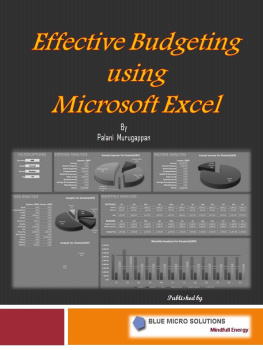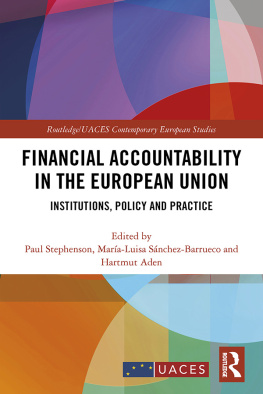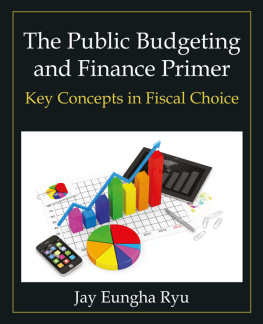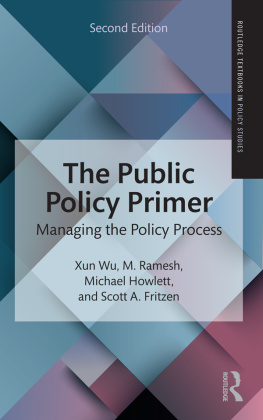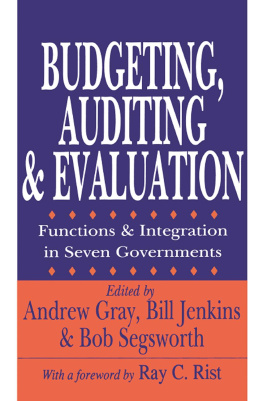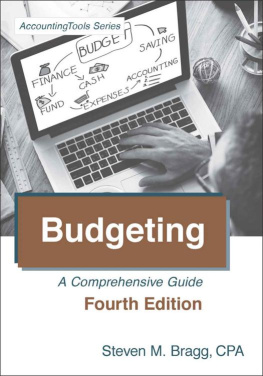Canadian Public Finance
Explaining Budgetary Institutions and the Budget Process in Canada
GENEVIVE TELLIER
TRANSLATED BY KTHE ROTH
UNIVERSITY OF TORONTO PRESS
Toronto Buffalo London
French title: Les finances publiques au Canada: Le fonctionnement de ltat la lumire du processus budgtaire (Bruxelles: ditions Bruylant 2015)
University of Toronto Press 2019
utorontopress.com
Printed in Canada.
All rights reserved. The use of any part of this publication reproduced, transmitted in any form or by any means, electronic, mechanical, photocopying, recording, or otherwise, or stored in a retrieval system, without prior written consent of the publisheror in the case of photocopying, a licence from Access Copyright (the Canadian Copyright Licensing Agency) 32056 Wellesley Street West, Toronto, Ontario, M5S 2S3is an infringement of the copyright law.
___________________________________________________________________________
Library and Archives Canada Cataloguing in Publication
Tellier, Genevive, 1962
[Finances publiques au Canada. English]
Canadian public finance : explaining budgetary institutions and the budget process in Canada / Genevive Tellier.
Translation of: Les finances publiques au Canada.
Includes bibliographical references and index.
ISBN 978-1-4875-9442-8 (hardcover). ISBN 978-1-4875-9441-1 (softcover)
1. CanadaAppropriations and expenditures. 2. CanadaAppropriations and expenditures, Provincial. 3. Municipal financeCanada.
I. Title. II. Title: Finances publiques au Canada. English.
HJ7663.T4513 2019336.71C2018-905778-5
___________________________________________________________________________
We welcome comments and suggestions regarding any aspect of our publicationsplease feel free to contact us at .
North America
5201 Dufferin Street
North York, Ontario, Canada, M3H 5T8
2250 Military Road
Tonawanda, New York, USA, 14150
ORDERS PHONE: 18005659523
ORDERS FAX: 18002219985
ORDERS E-MAIL:
This book is printed on acid-free paper with vegetable-based inks.
UK, Ireland, and continental Europe
NBN International
Estover Road, Plymouth, PL6 7PY, UK
ORDERS PHONE: 44 (0) 1752 202301
ORDERS FAX: 44 (0) 1752 202333
ORDERS E-MAIL:
University of Toronto Press acknowledges the financial assistance to its publishing program of the Canada Council for the Arts and the Ontario Arts Council, an agency of the Government of Ontario.

Preface to the English Edition
This book is the English translation of one written in French at the request of a European publisher. Such a request from abroad gives a good indication of the curiosity that exists outside of Canada about how Canadian public institutions function and, in particular, the countrys budgetary process. Indeed, Canada is often cited for its budgetary control mechanisms, which have been in place for quite a few years now to slow the growth of public expenditures, and its federal system, which emphasizes the sharing of jurisdiction (including fiscal responsibilities) among different levels of government.
It quickly became clear, as I was writing this book, that its content also had to target a Canadian readership. Very little has been written explaining how Canadian governments formulate and manage their budgets and addressing the role that budgets play in todays democracies. Moreover, many of the studies published on Canada are limited in scope, analysing either the federal government or a single province. Although the budgetary systems of the federal and provincial governments are similar, they are not identical, and some provincial and territorial governments have recently undertaken important innovations. Therefore, I wrote this book for both Canadian and foreign readers, and I have tried to present an overall view of budgetary policies and issues across Canada, rather than focusing on the federal scene or on a single province or territory.
This edition is not significantly different from the original French one. However, I have made some changes. First, I updated most of the statistical and budgetary data presented in the tables and figures in order to present the most recent information available. Second, I added new English-language references, especially in the reading suggestions at the end of each chapter. I did not remove all the sources in French, since it seemed important to supply the broadest possible range of research on public finance in Canada. Finally, I included certain changes adopted recently that modify the budgetary procedure (for example, the Parliamentary Budget Officer of the Canadian Parliament is now an independent parliamentary agent), although they do not substantially transform the budgetary process. However, some proposed reforms that could have important repercussions, including presentation of gender-sensitive budgets, Senate reforms (notably with regard to adoption of bills), and changes to the information contained in the reports to be submitted to Parliament, have a serious chance of being adopted. At time of writing, these reforms were still on the drawing board, and we will no doubt have to wait several years to evaluate their effects if adopted.
In closing, I would like to acknowledge the following people and organizations for their support for this project: Mat Buntin, of the University of Toronto Press, for the valuable support he provided since the early stages of this project; Kthe Roth, who translated the book, and whose judicious suggestions helped me focus my thoughts; the external evaluators for their enthusiasm and relevant comments (and I will ask their forgiveness if certain expectations were not fully met); and the Secrtariat du Qubec aux relations canadiennes, for the financial assistance provided in the framework of its activities to support the promotion of works by francophone researchers across Canada. Finally, this book could not have been written without the contributions of my students, many of whom, over the years, have asked me questions and proposed avenues for further thought. Teaching is certainly one of the greatest sources of inspiration for academic research.
Genevive Tellier
Ottawa, January 2018
CANADIAN PUBLIC FINANCE
Explaining Budgetary Institutions and the Budget Process in Canada
Introduction
It is not particularly easy for the general public to participate in debates over public finance. The themes discussed are often abstract, deal with complex subjects, and generally use very technical terms. The result is that discussions around the state of public finance usually take place among experts (such as economists, tax experts, policy analysts, and jurists) in specialized circles (economics journals and magazines, research institutes, government departments, and similar places). Yet questions about public finance should concern us all. Our governments budgetary choices reflect societys choices, and they have impacts on a great many of our daily activities. In addition, we contribute directly to funding the states activities through our taxesa financial contribution that gives us the legitimate right to discuss budgetary choices. This does not mean that all of us must take an active part in such discussions and decisions; we elect representatives to do this in our place. Nevertheless, we can certainly make our preferences known to our representatives and form our own opinions on public finance issues. The fact remains, however, that the general public has become more and more disengaged from public affairs. This democratic deficit is observed both in the marked drop in voter turnout (we rejoice when national voter turnout is above 70 per cent, even though this means that more than a quarter of those eligible have not voted) and in public opinion polls about trust in government (less than 50 per cent of the population in most industrialized countries trusts the public authorities). Canada is not an exception to this rule.



